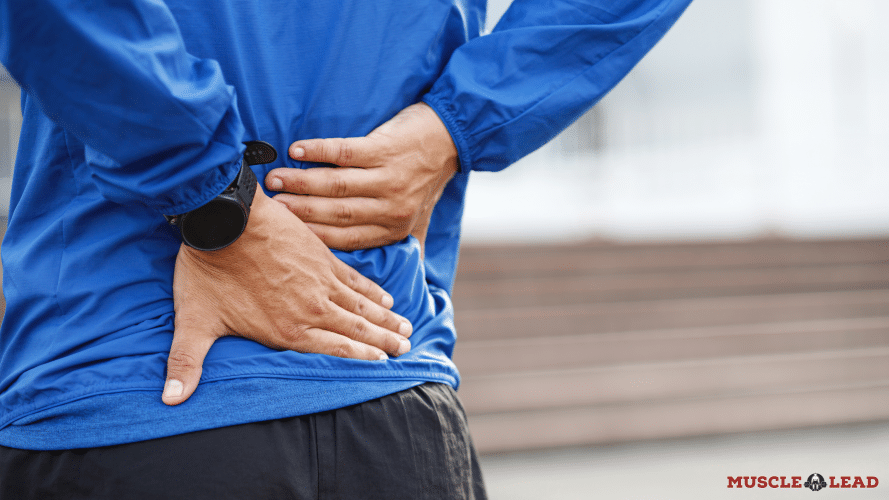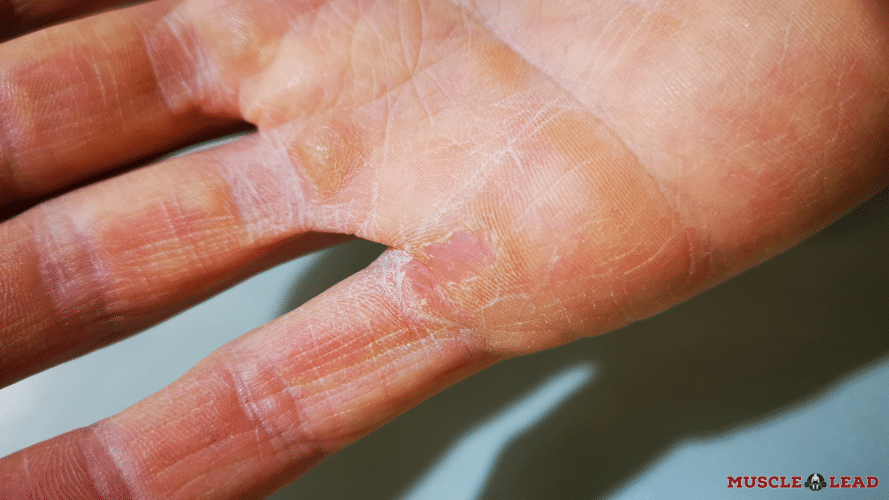The deadlift is one of the best strength training exercises that exist. One of the reasons why so many lifters avoid it is due do common deadlift injuries.
No way to sugar coat the issue here. There are many possible injuries from the deadlift.
The good thing is, we discuss 10 possible deadlift injuries and how to avoid them. This puts you one step ahead of the game. Giving you a better chance at a safe and effective lifting journey.
Why Should You Deadlift?
The deadlift is amongst the top 3 strength training exercises. Firstly, it is a show of strength. Secondly, it builds muscle strength and size.
Thirdly, it improves overall mobility and movement patterning that can translate into daily activities and sports. Last but not least, it helps burn calories and supports weight management.
Read more about Fixing Elbow Pain from Deadlifting
10 Common Deadlift Injuries
In no order we have highlighted and discussed 10 possible injuries during the deadlift. Some injuries are more common than others, but all are possible.
These possible injuries include:
- Distal Bicep Tear
- Herniated Spinal Disk
- Erector Spinae Strain
- Knee Damage
- Upper Thigh Damage
- Dislocated Shoulder
- Minor Shin Damage
- Hand Calluses
- Sprained Ankle
- Burst Blood Vessels
1. Distal Bicep Tear
Probably one of the most gruesome looking deadlift injuries. You must have seen this on the net? The bicep tendon (1) literally rips off the arm and curls up into a ball.
Lifters are more prone to bicep tears when they use the mixed grip. Although this may give you a better grasp of the bar, it puts your bicep in a vulnerable position.
Say a lifter is not able to deadlift a certain load. It is natural to try compensating with some elbow flexion (curling).
If the load is too heavy for the biceps to handle or a lifter is fatigued, chances are that it would tear.
My top tip to avoid the distal bicep tear would be to deadlift within capable intensities. Secondly, use the double overhand hand grip instead of the mixed grip.
2. Herniated Spinal Disk as the Second among Deadlift Injuries
During deadlifts, bad habits or ego lifting can lead to curving of the lower spine. This loads the spine with an unnatural amount of pressure. The risk of injuries, spinal disk damage or hernia is high (2).
I have personally come across lifters who have really put their ego lift on. This is followed by hideous form and injury. Literally takes them out of action for months on top of months.
If you do not quite fancy a herniated disk, here is what you need to do. Ensure that you maintain a neutral spine throughout the deadlift.
To do so you need to brace the core. If they are not strong enough, you can condition them through core stability exercises.
Do Deadlifts Thicken Your Waist? No, Here’s Why
3. Erector Spinae Strain
Lifting too “heavy” can bring out erector soreness or strain. Some lifters tend to hyper extend the back too much to finish off the deadlift. This can also bring out some muscle strain.
I have experienced this and it is awful! I was in constant pain and could not even walk properly. Other lifts were also affected, like the bench press and shoulder press.

To avoid the erector injury, work within your deadlift intensities. Secondly, try not to bend the back too far.
4. Knee Damage
The deadlift is not the worst exercise for the knees, but still has some risks. There is a knee hinge movement during the deadlift.
Continuous deadlift or hyper extending the knees can cause overuse injuries. This typically affects the ligaments (ACL) and cartilage (meniscus) surrounding the joint.
My best tip would be to try not to straighten the knees too much. Do not go past a 0 degree knee angle.
5. Upper Thigh Damage
Upper thigh damage is common in one deadlifting situation. Lifters who hitch the bar. The deadlift hitch is when a lifter rests the bar on the upper thigh. This is followed by jerking and building momentum with the quads.
The bar would constantly hit the upper leg. Potentially bringing out a blunt force Injury. Such injuries could include a strained quad or fractured upper thigh bone.
To avoid this problem, simply avoid hitching. Hitching can be addressed by strengthening the hip hinge muscles. You should also stay within your means of medium to max deadlift load.
6. Dislocated Shoulder
Dislocations look nasty, but most of the time they are just a quick fix. Dislocations are basically when the shoulder joint is forced out of its socket.
A healthcare professional will use some anesthetics then pop it right back in. There is usually a recommended time frame to lay any activity off the shoulder.
Dislocations are known to happen during deadlift. It is even more risky when you do not lift with the shoulders braced.
To bring down the risk of shoulder dislocations, brace the shoulder joints/shoulder blades. Furthermore, warm up the shoulder joint to get more synovial fluid flowing.
7. Minor Shin Damage
Shin contact is unavoidable during the deadlift. This comes with bruising and bleeding. But Why? To get the best out of the deadlift you need to keep the bar close to the body.
This gives the best center of gravity to work the muscles properly. Furthermore, it puts the body in the right position to avoid other more serious injuries. As you will learn, with proper intervention we can minimize shin damage.
Personally, I just take the scrapes. But if you really do not like them, try covering your shins. You can use a base layer or shin sleeves.
How to Prevent Deadlift Shin Scrape? Proven Ways
8. Hand Calluses
Grasping and ripping the deadlift and tearing the skin and even flesh on the hands. The heavier the go the higher the risk.
I remember deadlifting 617 for a single. The skin and some flesh literally ripped off my hand. it was not a case for an emergency room, but still bloody and painful.
Another minor injury that I have always embraced. For those who want to lower the damage, you could use some grippy gloves.
9. Sprained Ankle
With certain foot placements you can sprain the ankle. If you drift your weight onto the outer part of a foot, there is a chance of over tilting and injuring the ankle ligaments.
The outer ligaments are more prone to tilting and injury as it is the least stable side.

If you do not want those to happen to you try putting your weight on the heel/midfoot. While lifting, drift the weight to the midfoot/balls of the feet. This can help stop tilting and loading the ankles outwards.
10. Burst Blood Vessels
An immense amount of blood pressure is built up during the heavy deadlift. This can burst blood vessels around the.
A common telltale sign of a burst blood vessel is sudden nose bleeds and bloodshot red eyes.
In most cases, burst blood vessels should not pose a problem. Although with personal experience, I can tell you that they can be very uncomfortable and sometimes painful.
Essentially, you can lower this injury risk by breathing in and out during the deadlift. Generally, I suggest taking a deep breath and holding it before lifting. When you pull the bar up to the hip position, begin to release the breath.
Final Thoughts
We know there are many deadlift related injuries. You could pretty much avoid these injuries by maintaining good deadlift form.
As a take home message, we have highlighted the key points that can help prevent injuries during the deadlift
Frequently Asked Questions
The most common deadlift injuries are usually back related.
The bicep rupture. It takes a surgical repair followed by months and months out of rehab.
Absolutely! Deadlifts are great lower body builders amongst many other benefits.
Disc damage will feel sharp, whereas soreness will feel sore and fatigued.
References
- Wishperout (2022). “Scary bicep tear Strongman” Available at:https://youtube.com/shorts/Mm9om7rw0TI?feature=share (Accessed 28/02/2023)
- Stock, M.S., Bodden, M.E., Block, J.M., et al. “Acute, Non-Specific Low Back Pain Does Not Impair Isometric Deadlift Force or Electromyographic Excitation: A Cross-Sectional Study” Sports. 2022; 10(11): 168





